House Safety Rules: Checklist and Safe Home Tips
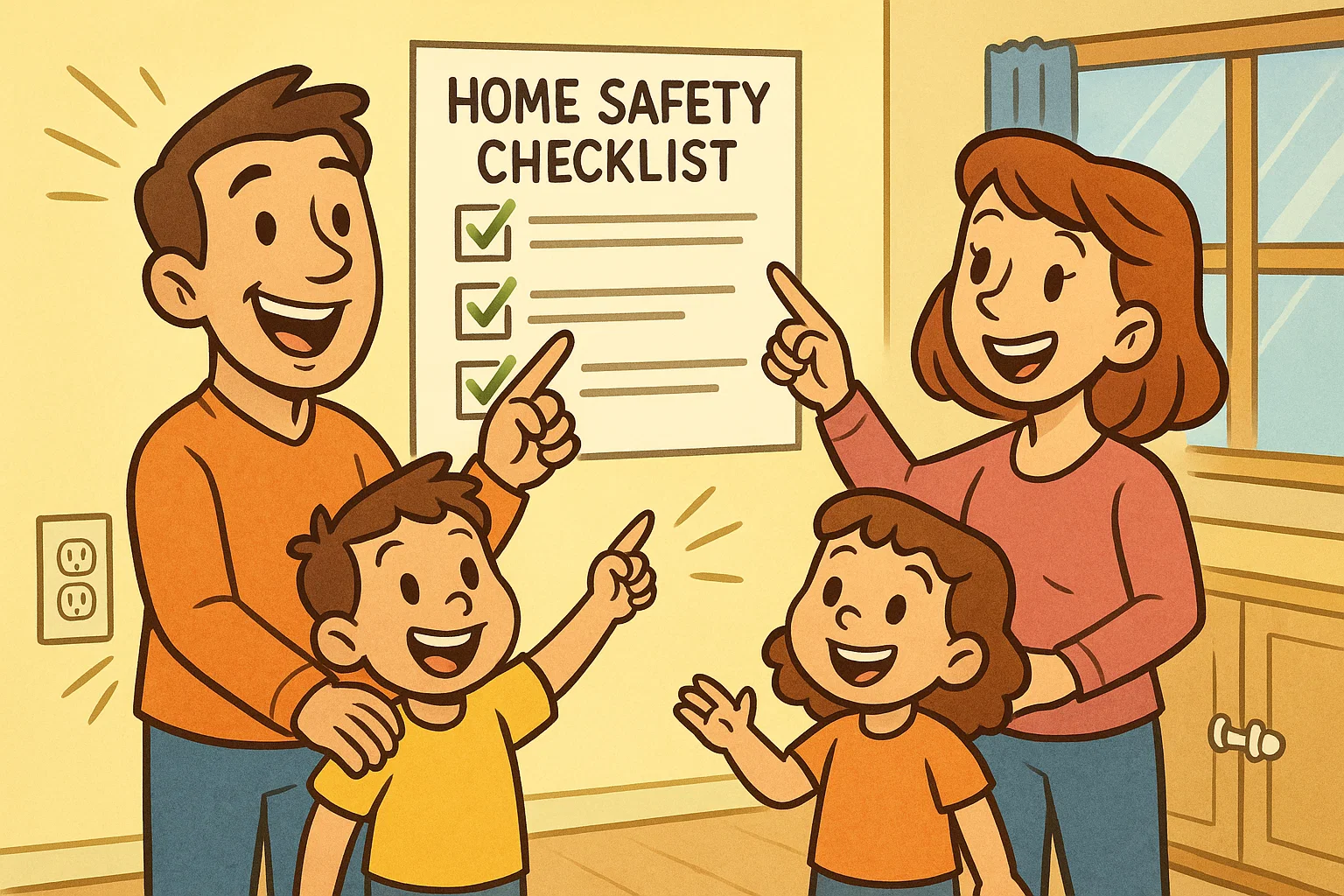
Creating a safe home environment requires consistent attention to detail and proactive safety measures. According to the National Safety Council, unintentional home injuries account for approximately 53.6 million medically consulted injuries annually in the United States. This comprehensive guide provides practical safety rules and a detailed checklist to help you protect your family and create a secure living environment.
General Safety Measures and Preparedness
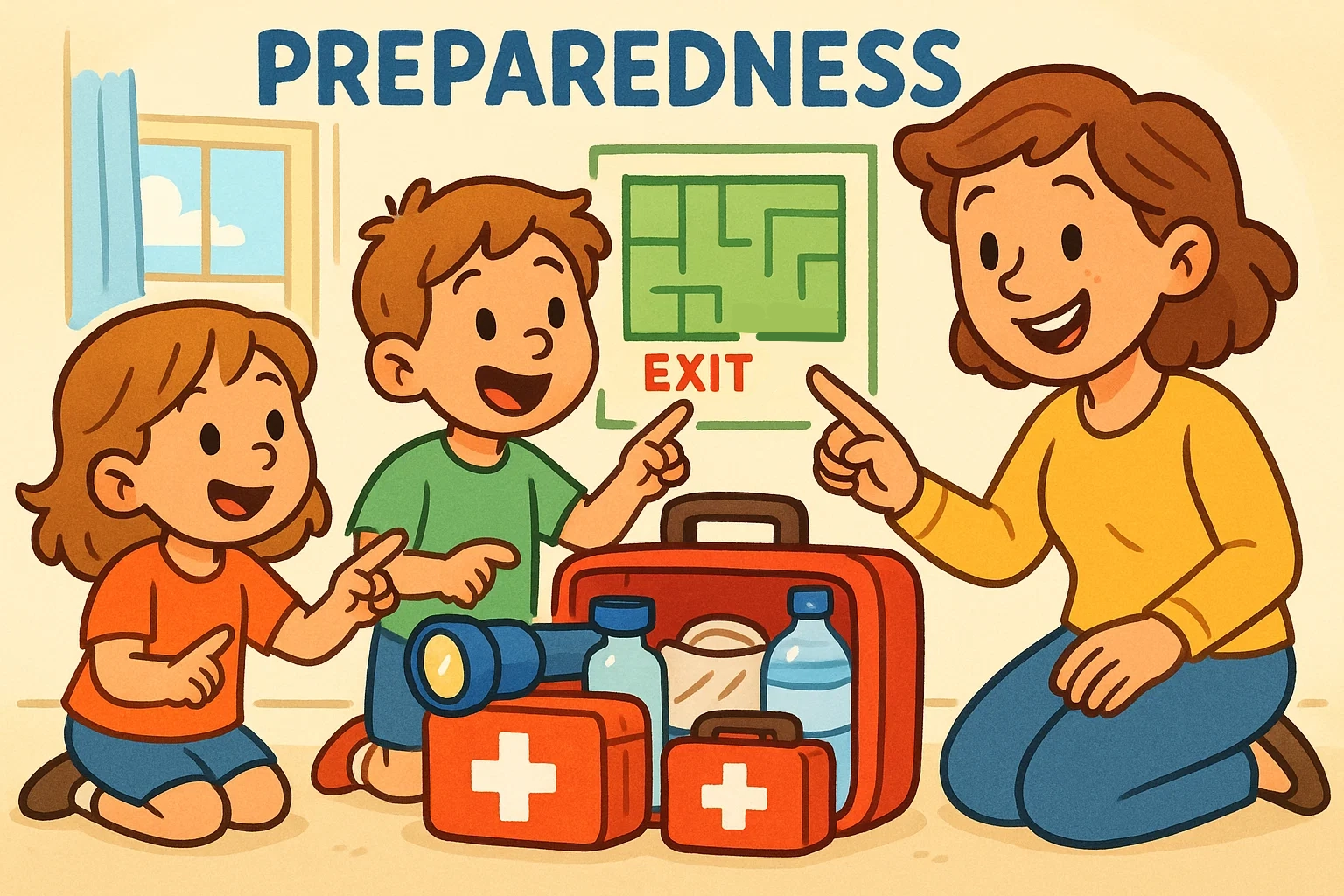
Building a foundation of safety at home begins with establishing essential protocols and maintaining readiness for emergencies. These fundamental safety practices form the backbone of a secure household.
Create an Emergency Exit Plan and Checklist
Every household needs a well-rehearsed home emergency plan that outlines clear evacuation routes. Draw a floor plan showing at least two ways out of every room, particularly bedrooms. Designate a safe meeting place outside, away from the home—a neighbor’s mailbox or a specific tree works well.
Practice your emergency plan at least twice a year. During drills, time how long evacuation takes and identify potential obstacles. Consider different scenarios:
- A fire blocking the main staircase
- An emergency occurring at night when visibility is limited
- Situations requiring assistance for family members with mobility challenges
- Evacuation during different weather conditions
Essential Emergency Plan Components:
- Two exit routes from every room
- Designated outdoor meeting place
- Assigned responsibilities for helping children or elderly family members
- Alternative communication plan if separated
- Regular practice drills (minimum twice yearly)
Your home safety checklist should include verifying that all family members can unlock windows and doors quickly, even in darkness. Keep a flashlight and whistle in each bedroom for signaling help if someone becomes trapped.
Keep Emergency Contact Numbers Handy
Create a list of emergency numbers and post it in multiple locations throughout your home—near telephones, on the refrigerator, and inside your first aid kit. Include:
- 911 or local emergency services
- Poison Control Center (1-800-222-1222)
- Your family doctor’s office
- Local hospital emergency room
- Nearest relatives or trusted neighbors
- Utility company emergency lines (gas, electric, water)
Program these numbers into every household mobile phone and teach children how to make emergency calls. Even young children can learn to dial 911 and provide their address when necessary.
Maintain a First Aid Kit for Preparedness
A well-stocked first aid kit serves as your first line of defense when injuries occur. Store your kit in an accessible location that adults can reach quickly but remains secure from children’s access.
Essential First Aid Kit Contents:
| Category | Items |
| Wound Care | Adhesive bandages (various sizes), sterile gauze pads, adhesive tape, antibiotic ointment, antiseptic wipes |
| Medications | Pain relievers (acetaminophen, ibuprofen), antihistamine, hydrocortisone cream, anti-diarrheal medication |
| Tools | Tweezers, scissors, thermometer, disposable gloves, instant cold packs |
| Emergency | CPR face shield, emergency blanket, first aid manual, list of emergency numbers |
Check your first aid kit every six months, replacing expired medications and replenishing used supplies. Consider taking a first aid and CPR course through organizations like the American Red Cross to enhance your preparedness.
Regular Home Inspection for Safety
Schedule quarterly walk-throughs of your home to identify potential hazards before they cause harm. Look for loose handrails, frayed electrical cords, unstable furniture, and burned-out bulbs in stairways or hallways.
Inspect areas that often escape regular attention: the basement for moisture problems, the attic for proper insulation and ventilation, and outdoor spaces for tripping hazards like uneven pavement or exposed tree roots. Document your findings and address issues promptly.
Pay special attention to seasonal changes that may create new risks. Winter may bring ice on walkways, while summer increases fire risk from dry vegetation near the home.
Get Safety Certificates for Your Home
Professional inspections provide expert evaluation of critical safety systems. Many jurisdictions require specific certifications for home sales, but these assessments benefit any household.
Consider obtaining certificates for:
- Gas appliances and heating systems (annual inspection recommended)
- Electrical systems (every 10 years or when purchasing a home)
- Smoke and carbon monoxide detector functionality
- Fire extinguisher servicing (annually)
Keep these certificates organized in a household safety binder along with product manuals, warranty information, and maintenance records. This documentation proves valuable during emergencies and when filing insurance claims.
Personal Preparedness Actions for Staying Safe at Home
Individual awareness significantly reduces accident risk. Teach all household members to stay alert and avoid distractions when performing potentially dangerous tasks.
Develop personal safety habits: wear appropriate footwear inside the home to prevent slips, use a step stool rather than standing on chairs, and never rush on stairs. These simple practices may seem minor but prevent thousands of injuries annually.
Encourage family members to report potential hazards immediately rather than assuming someone else will notice. A loose carpet edge or wobbly cabinet represents an accident waiting to happen.
Fire Safety and Security Around the Home
Home fires remain one of the most devastating household emergencies, with the National Fire Protection Association reporting a home fire occurring every 93 seconds in the United States. Implementing comprehensive fire prevention measures dramatically reduces this risk.
Check Smoke and Carbon Monoxide Detectors
Install smoke detectors on every level of your home, inside each bedroom, and outside sleeping areas. Carbon monoxide detectors belong near sleeping areas and on every floor, particularly near fuel-burning appliances.
Test alarms monthly by pressing the test button. Replace the batteries at least twice yearly—many people coordinate this with daylight saving time changes. Smoke alarms themselves require replacement every 10 years, while carbon monoxide alarm lifespan varies by model (typically 5-7 years).
Never disable a smoke alarm due to nuisance alarms from cooking. Instead, relocate the detector away from the kitchen or install a photoelectric model that’s less sensitive to cooking smoke.
Never Leave Open Flames Unattended
Unattended candles cause an estimated 7,600 home fires annually. Establish a firm rule: extinguish all candles, incense, and oil lamps before leaving a room or going to sleep.
Use stable, non-flammable candle holders placed on heat-resistant surfaces away from curtains, papers, and other combustibles. Keep burning candles at least 12 inches from anything that can catch fire.
Consider flameless LED candles as a safe alternative for ambiance. These battery-operated options eliminate fire risk entirely while providing similar lighting effects.
Keep Flammable Items Away From Heat Sources
Store flammable liquids like gasoline, paint thinner, and lighter fluid in approved containers outside the living space—preferably in a detached garage or shed. Never store these materials near heat sources, pilot lights, or electrical equipment.
Maintain a three-foot “kid-free zone” around fireplaces, wood stoves, and space heaters. Keep newspapers, magazines, fabrics, and decorations away from heating equipment.
In case of fire, having clear spaces around heat sources may provide crucial seconds for safe evacuation. This principle applies equally to preventing fire spread and facilitating emergency response.
Fire Safety Rules for the Kitchen
Cooking causes 49% of all home fires, making the kitchen the most dangerous room regarding fire risk. Never leave cooking unattended, especially when frying, grilling, or broiling food. Stay in the kitchen when cooking on the stove top.
Keep pot handles turned inward to prevent accidental spills and ensure children cannot reach them. Wear short sleeves or roll up long sleeves when cooking to prevent fabric from catching fire.
Keep a fire extinguisher rated for kitchen fires (Class K or multi-purpose ABC) within easy reach but away from the stove. If a grease fire starts, never use water—instead, slide a lid over the pan to smother flames or use the fire extinguisher.
Install Fire Extinguishers and Review Safety Measures
Place fire extinguishers in key locations: the kitchen, garage, workshop, and near furnaces. Mount them in visible, easily accessible spots where heat or flames won’t block access during emergencies.
Learn the PASS technique for fire extinguisher use:
- Pull the pin
- Aim at the base of the fire
- Squeeze the handle
- Sweep from side to side
Fire extinguishers require annual professional inspection and pressure gauge checks monthly. Replace single-use extinguishers after any discharge, even partial use.
Remember that fire extinguishers only work on small, contained fires. If flames spread beyond a trash can’s size, evacuate immediately and call 911 from outside.
Guarding Against Intruders: Home Security and Protection
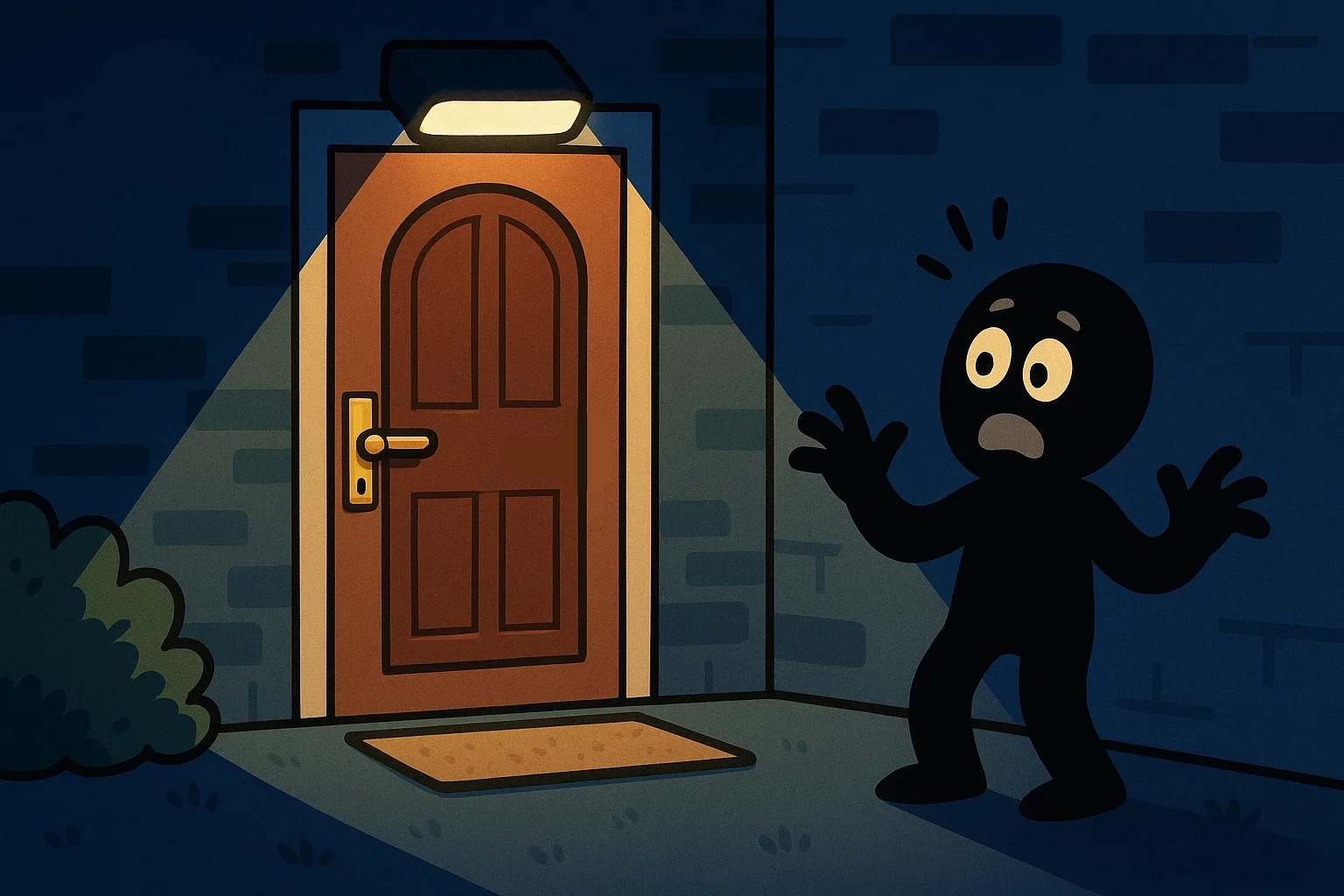
While fire safety addresses accidental dangers, home security focuses on protecting against intentional threats. The FBI reports a burglary occurs every 25.7 seconds in the United States, making security measures essential for peace of mind and family protection.
Keep Doors Closed and Locked for Security
Develop a consistent habit of locking all doors and windows, even when home. Approximately 34% of burglars enter through the front door, and many gain access through unlocked entrances.
Install deadbolt locks on all exterior doors—they provide significantly better security than standard spring-bolt locks. The deadbolt should extend at least one inch into the door frame.
Create a family routine: the last person to bed checks all locks, and everyone locks doors immediately upon entering the home. This simple practice eliminates the “I’ll do it later” mentality that creates vulnerabilities.
Turn On Security Lights at Night
Outdoor lighting dramatically deters intruders, who prefer working under darkness cover. Install motion-activated lights at all entrances, along walkways, and in the driveway.
Position lights to illuminate the entire entry area, eliminating shadows where someone might hide. Consider lighting on timers that automatically turn on at dusk, creating the appearance of occupancy.
Smart lighting systems allow remote control via smartphone, enabling you to turn lights on or off from anywhere. This feature proves particularly valuable when away from home or arriving after dark.
Install Security Cameras and Alarm Systems
Modern security cameras provide affordable monitoring options with smartphone access. Position cameras to cover main entrances, garage doors, and backyards. Visible cameras alone deter many potential intruders.
Professional alarm systems offer 24/7 monitoring, with authorities contacted automatically when triggered. Even basic systems significantly reduce burglary risk.
Display security system signs and window decals prominently. These indicators alone discourage many would-be intruders from targeting your home.
Secure Exterior Doors and Windows
Reinforce exterior doors with strike plates secured by 3-inch screws that anchor into wall studs, not just the door frame. Replace hollow-core exterior doors with solid wood or metal doors.
Sliding glass doors require additional security beyond their factory locks. Install a security bar in the track to prevent forced opening, or use a dowel cut to fit the track length.
Ground-floor and easily accessible windows need secure locks. Consider installing window security film, which holds glass together if broken, and window guards that prevent opening more than four inches while allowing emergency escape.
Security Measures When Vacationing Away From Home
An unoccupied home attracts burglars. Before traveling, stop mail and newspaper delivery, or ask a trusted neighbor to collect them daily. Accumulated mail signals absence.
Use timers or smart devices to turn lights, televisions, and radios on and off at varying times, simulating normal occupancy patterns. Consider leaving a vehicle in the driveway if possible.
Inform trusted neighbors of your absence and provide contact information. Ask them to watch for suspicious activity and park in your driveway occasionally. Never announce vacation plans on social media until after returning home.
Electrical Safety Rules and Appliance Use
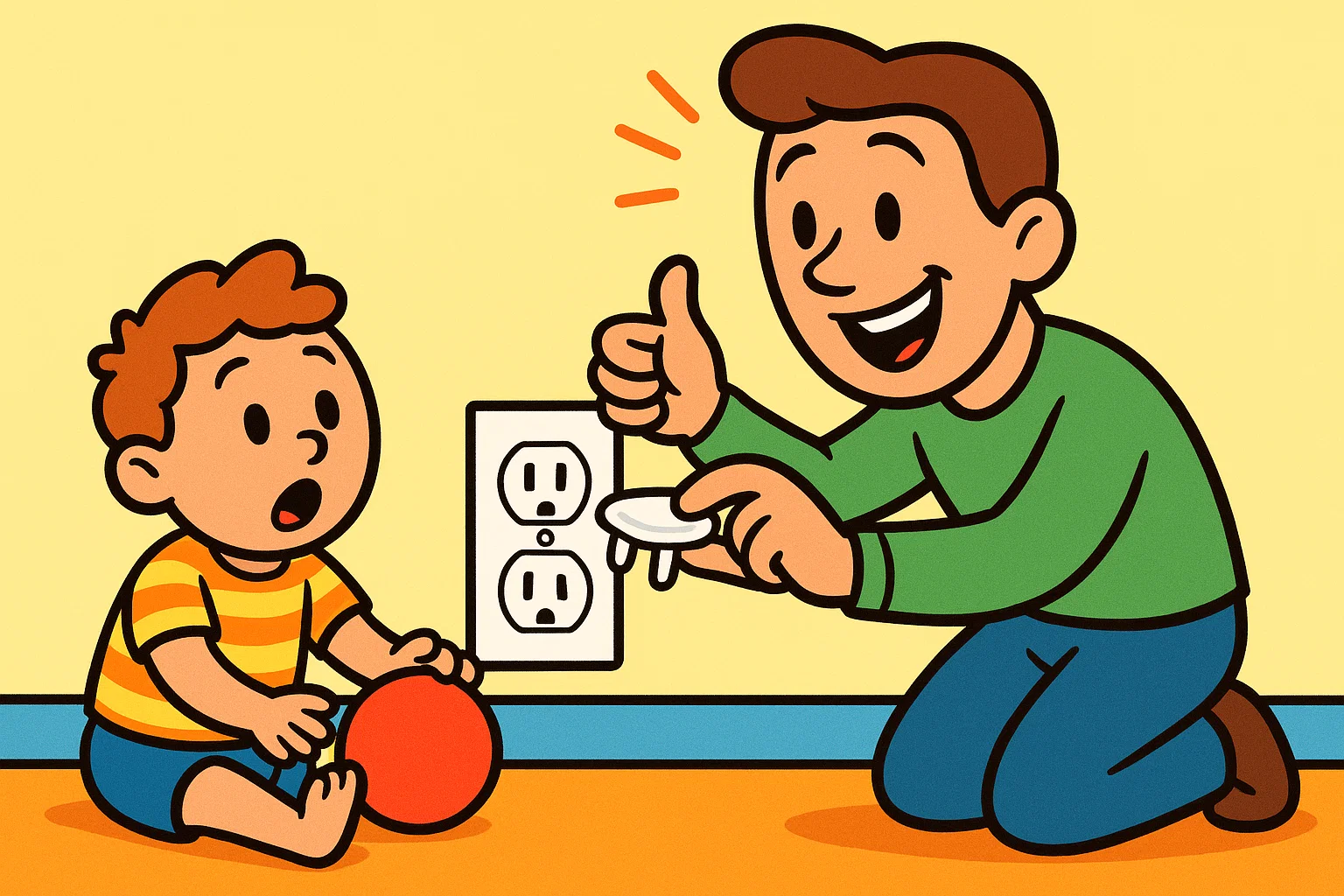
Electrical hazards cause approximately 51,000 home fires annually, according to the Electrical Safety Foundation International. Understanding proper electrical safety practices protects your family from shock, fire, and electrocution risks.
Cover Electrical Outlets
Uncovered outlets pose risks to young children, who may insert objects into openings. Install safety covers on all accessible outlets throughout your home.
Choose tamper-resistant outlets for the best protection—these feature internal shutters that only open when equal pressure is applied to both slots simultaneously, as occurs when inserting a plug. Standard safety caps can be removed by curious children.
When using outlet covers, ensure they fit snugly and replace any that become loose or damaged. Consider replacing standard outlets with tamper-resistant models during home renovations.
Secure Electrical Cords and Wires
Keep cords organized and away from traffic areas to prevent tripping. Never run cords under rugs or furniture, where friction and pressure can damage insulation and create fire hazards.
Inspect cords regularly for fraying, cracks, or damage. Replace damaged cords immediately—never attempt repairs with electrical tape. Check that cords aren’t pinched by furniture or in doorways.
Use cord organizers and cable management solutions to keep wires tidy. Label cords to identify which appliance they serve, making it easier to unplug unused items.
Stay Away From Electrical Outlets and Appliances
Teach children to never insert anything into electrical outlets or appliances. Explain that electricity is dangerous and should only be handled by adults.
Maintain a safe distance from major appliances during operation. Children should understand that climbing on appliances or playing near them while they’re running creates serious risks.
Unplug small appliances when not in use. This practice prevents electrical fires, saves energy, and protects against power surge damage.
Check and Maintain Kitchen Appliances
Kitchen appliances work hard and require regular inspection. Check refrigerator coils quarterly and clean accumulated dust, which forces the motor to work harder and increases fire risk.
Inspect toaster crumb trays monthly and clean them to prevent buildup that can ignite. Examine coffee makers and other small appliances for frayed cords or damaged plugs.
Register appliances with manufacturers to receive recall notices. The Consumer Product Safety Commission reports numerous appliance recalls annually due to fire or electrical hazards.
Keep Electrical Items Away From Water
Water and electricity create lethal combinations. Never use electrical appliances near sinks, bathtubs, or other water sources unless specifically designed for that purpose.
Install ground fault circuit interrupter (GFCI) outlets in bathrooms, kitchens, laundry rooms, and outdoor areas. These devices detect electrical imbalances and shut off power within milliseconds, preventing electrocution.
Keep hairdryers, curling irons, and other electrical grooming tools away from water. Unplug these items immediately after use and store them in dry locations.
Child Safety Measures and Childproofing
Children under five face the highest risk of unintentional home injury. The Centers for Disease Control and Prevention reports that proper childproofing can prevent up to 85% of these injuries.
Comprehensive Childproofing Checklist
Creating a safe environment for children requires viewing your home from a child’s perspective. Get down to their eye level in each room to identify potential hazards you might otherwise miss.
Room-by-Room Childproofing Essentials:
| Room | Safety Measures |
| Living Room | Secure TV and furniture, cover outlets, pad sharp corners, remove small objects |
| Kitchen | Install safety gates, secure cabinets, use stove knob covers, lock away cleaning products |
| Bathroom | Lock medicine cabinet, install toilet locks, secure cabinet under sink, adjust water temperature |
| Bedrooms | Secure dressers and bookshelves, use cordless window coverings, remove choking hazards |
| Stairs/Hallways | Install safety gates top and bottom, ensure handrail security, remove tripping hazards |
Update childproofing as children grow and develop new abilities. What secures a crawler may not protect a toddler who can climb.
How to Keep Children Safe at Home
Active supervision remains the most effective child safety measure. However, combining vigilance with environmental modifications creates multiple protection layers.
Establish clear safety rules that children understand: no running indoors, no climbing on furniture, no touching hot surfaces. Consistently enforce these rules to build safe habits.
Create safe play areas where children can explore without constant danger. Use baby gates to block access to stairs, kitchens, and other hazardous areas when you cannot provide direct supervision.
Keep Small Objects Out of Reach
Choking causes thousands of emergency room visits annually among children under five. Any object that fits through a toilet paper tube presents a choking hazard for young children.
Regularly scan floors, low shelves, and accessible drawers for small objects like coins, buttons, batteries, and toy parts. Pay special attention after hosting guests, who may not be aware of choking risks.
Teach older siblings to keep their small toys away from younger children. Create separate play areas when possible, giving older children space for age-appropriate toys while protecting younger siblings.
Secure Heavy Furniture and Appliances
Furniture tip-overs cause approximately 38,000 injuries annually. Secure all tall furniture to walls using furniture straps or L-brackets—don’t assume weight alone provides stability.
Anchor televisions on dressers or stands, or mount them directly to walls. Never place items that attract children (toys, remotes) on top of furniture, as this tempts climbing.
Keep heavy items on lower shelves and drawers to prevent top-heavy furniture. Remove drawer stops so drawers come completely out if pulled, preventing children from using them as climbing steps.
Teach Kids About Home Safety Tips
Age-appropriate safety education empowers children to protect themselves. Begin teaching basic safety concepts as early as age two, when children can start following simple rules.
Use storytelling and role-playing to make safety lessons engaging. Practice what to do if the smoke alarm sounds, how to safely cross rooms without running, and why certain areas are off-limits.
As children mature, expand their safety knowledge. School-age children can learn about fire safety, electrical hazards, and how to call for help. Teenagers should understand all household safety systems and emergency procedures.
Dispose of Items That Create Hazards
Regularly evaluate toys and household items for safety. Discard broken toys, items with small parts that have come loose, or playthings that no longer meet safety standards.
Safely dispose of button batteries, which pose extreme danger if swallowed. Keep these batteries in their original packaging until use, and recycle used batteries according to local guidelines.
Remove recalled items immediately. Register products with manufacturers to receive recall notifications, and check the Consumer Product Safety Commission website regularly.
Kitchen Safety Rules and Sharp Objects
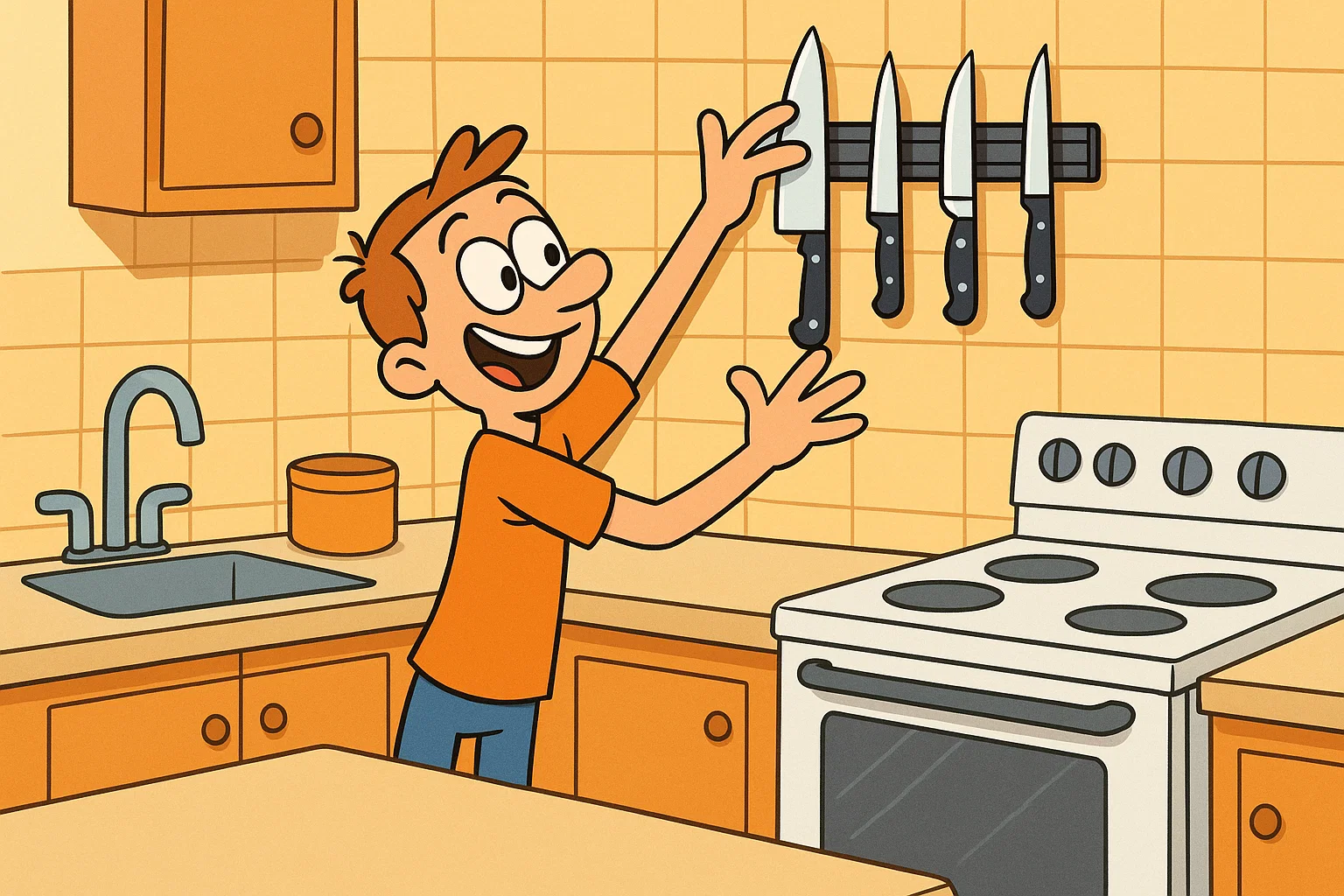
The kitchen combines multiple hazards: heat sources, sharp tools, electrical appliances, and slip risks. Implementing comprehensive kitchen safety rules protects everyone who enters this high-traffic area.
Never Leave Cooking Unattended
Unattended cooking is the leading cause of home fires. Stay in the kitchen when frying, boiling, grilling, or broiling food. If you must leave briefly, turn off the stove.
When simmering, baking, or roasting food, remain in the home and check regularly. Set timers as reminders to check on cooking food—it’s easy to become distracted and forget.
Avoid cooking when drowsy or after consuming alcohol. These conditions impair judgment and reaction time, increasing accident risk significantly.
Clean Up Spills Immediately
Wet floors create serious slip hazards. Clean spills immediately, including water, oil, food, and beverages. Use appropriate cleaning methods—grease requires more than just water.
Place a “wet floor” sign or towel near the spill while cleaning to warn others. Dry the area thoroughly; even thin moisture films can cause falls.
Keep spills from occurring by wiping container rims before returning them to shelves and using appropriate-sized containers for liquids. Prevention requires less effort than cleanup and eliminates slip risks.
Use Sharp Objects (Knives) Safely
Sharp tools demand respect and careful handling. Store knives in a knife block, on a magnetic strip, or in a drawer with blade guards—never loose in drawers where someone could inadvertently grasp the blade.
Always cut on a stable cutting board, never in your hand or on unstable surfaces. Cut away from your body and keep fingers clear of the blade path. Use proper cutting techniques, curling fingertips inward while holding food.
Keep knives sharp; dull blades require more pressure and are more likely to slip. Clean knives immediately after use rather than leaving them in soapy water where someone might reach in blindly.
Stay Away From the Kitchen During Cooking Times
Establish a “kitchen closed during cooking” rule for children. Designate a safe zone at least three feet from the stove where children must remain if they need to be present.
Young children should be kept out of the kitchen entirely during cooking. Use baby gates to prevent access, or have someone supervise them in another room.
This rule particularly applies when handling hot liquids, removing items from ovens, or cooking foods that splatter. These activities create risks even with careful attention.
Safe Handling of Food and Appliances
Food safety and appliance operation both require attention to detail. Keep hot foods hot (above 140°F) and cold foods cold (below 40°F) to prevent bacterial growth.
Understand your appliances’ proper operation. Read instruction manuals and follow manufacturer guidelines for safe use. Never attempt repairs on appliances while they’re plugged in.
Unplug appliances before cleaning them. Allow hot appliances to cool completely before handling or storing. These simple steps prevent numerous burns and electrical shocks annually.
Bathroom and Water Safety Around the Home
Bathrooms present unique hazards: slippery surfaces, water hazards, electrical appliances near moisture, and medications. The CDC reports that bathroom falls alone cause approximately 234,000 injuries annually.
Use Non-Slip Mats on the Floor
Place non-slip mats inside and immediately outside tubs and showers. These mats must have suction cups or rubber backing that grips flooring securely.
Replace mats when suction cups lose their grip or when visible wear appears. Periodically lift mats to clean underneath, preventing mildew growth that can damage flooring.
Consider textured adhesive strips for tub and shower floors if permanent solutions are preferred. These strips provide excellent traction and don’t require cleaning or replacement as frequently as mats.
Install Grab Bars
Grab bars provide crucial support for safe bathroom navigation, particularly for children, elderly individuals, and anyone with mobility limitations. Professional installation ensures bars support users’ full body weight.
Install bars near toilets, in showers, and beside bathtubs. Position them at appropriate heights for all household members who will use them. Bars must anchor into wall studs, not just drywall.
Distinguish grab bars from decorative towel bars, which cannot support body weight. Never use towel bars for balance or support—they will pull free from walls.
Adjust Water Heater Temperature
Set water heaters to 120°F or lower to prevent scalding burns. Water at 140°F can cause third-degree burns in just five seconds of exposure.
Test water temperature before bathing children, using your elbow or wrist rather than hands, which are less sensitive to heat. Consider installing anti-scald devices on faucets and showerheads for additional protection.
Teach children to turn on cold water first and add hot water gradually. This habit prevents sudden exposure to scalding water if the hot water handle is turned on fully.
Avoid Running on Slippery Floors
Establish a firm “no running” rule in bathrooms, where wet floors create extreme slip danger. Enforce this rule consistently, explaining the serious injury risk.
Keep bathroom floors as dry as possible. Use bath mats that absorb water dripping from wet bodies and hair. Encourage family members to wipe up water splashes immediately.
Ensure adequate lighting in bathrooms, particularly during nighttime hours. Install nightlights to help people navigate safely without turning on bright overhead lights.
Never Leave Children Alone By the Pool
Drowning is the leading cause of unintentional death for children ages 1-4. Active adult supervision is essential whenever children are near water—”water watchers” should avoid distractions like phones or books.
Install proper pool barriers: a four-sided fence at least four feet high with self-closing, self-latching gates. Pool covers and alarms provide additional layers of protection but never replace supervision.
Keep rescue equipment and a phone near the pool. Learn CPR and ensure multiple household members are trained. These skills can mean the difference between life and death in emergencies.
Medication and Poison Safety Measures
Poisoning accounts for over 2 million calls to poison control centers annually. Proper medication storage and awareness of poisoning risks are critical components of home safety.
Keep Medicines in a Safe Cabinet
Store all medications in locked cabinets or storage boxes, placed high and out of children’s sight. Never rely on child-resistant packaging alone—these containers slow access but aren’t childproof.
Keep medicines in their original containers with labels intact. This practice prevents confusion about contents, dosages, and expiration dates. Never transfer medications to unlabeled containers.
Regularly purge expired medications. Many communities offer medication take-back programs for safe disposal. Never flush medications unless specifically directed by disposal instructions.
Store Medications Securely
Separate adult medications from children’s medicines to prevent mix-ups during busy mornings or nighttime administration. Consider using a medication organizer for complex medication schedules.
Keep medications away from heat and moisture. Despite tradition, bathrooms are poor storage locations due to humidity and temperature fluctuations. A locked cabinet in a bedroom or closet often proves safer.
Maintain an updated list of all household medications, including prescriptions, over-the-counter medicines, and supplements. This list aids medical professionals during emergencies and helps track what’s in your home.
Always Ask Before Using Medicine
Teach children to never take medicine without adult permission and supervision, even if they’ve taken it before. Medications aren’t candy, despite attempts to make children’s medicines palatable.
Explain that taking someone else’s prescription medicine is dangerous. Each prescription is specifically dosed for that individual’s needs, weight, and conditions.
Keep the Poison Control Center number (1-800-222-1222) programmed in phones and posted visibly. If accidental ingestion occurs, call immediately—time is critical in poison cases.
Poison Prevention Tips for Home Safety
Poisoning extends beyond medications. Household cleaners, pesticides, automotive products, and plants can all poison children and pets.
Store all household chemicals in original containers with labels visible. Keep them in locked cabinets, preferably in garages or sheds away from living spaces. Never store cleaning products under kitchen sinks where children can access them.
Use cleaning products in well-ventilated areas and never mix products—combinations like bleach and ammonia create toxic fumes. Put products away immediately after use rather than leaving them accessible during cleaning.
Learn which household plants are toxic. Common decorative plants like philodendrons, pothos, and dieffenbachia can cause serious reactions if ingested. Consider removing toxic plants or placing them completely out of reach.
Addressing Miscellaneous Safety Risks Around the Home
Beyond major safety categories, numerous smaller risks exist throughout homes. Addressing these creates a comprehensive safety net protecting against diverse hazards.
Avoid Clutter and Maintain Cleanliness
Clutter creates tripping hazards and hides potential dangers. Maintain clear pathways through all rooms, ensuring furniture arrangement allows safe navigation.
Implement organizational systems that make staying clutter-free easier. Designate homes for items so they’re not left on floors or stairs. Encourage family members to clean as they go rather than allowing messes to accumulate.
Regular cleaning prevents pest infestations, which create both health risks and potential damage to your home. Address spills promptly to prevent slipping hazards and material damage.
Safe Furniture Placement
Position furniture thoughtfully, considering traffic flow and safety. Avoid placing furniture where it might block exits or create blind corners where collisions might occur.
Keep furniture away from windows to prevent children from climbing and potentially falling. Ensure window coverings use cordless designs or have cords secured out of children’s reach—blind cords pose strangulation risks.
Arrange furniture to prevent blocking heating vents, radiators, or air returns. Blocked vents reduce heating efficiency and can create fire hazards with certain heating types.
Keep the Laundry Room Locked
Laundry rooms contain numerous hazards: detergents and chemicals, hot water, machines with moving parts, and small spaces where children might become trapped. Keep this room locked when not in use.
Store laundry detergents, particularly liquid detergent pods, in original containers on high shelves. These colorful pods attract children and can cause serious poisoning if bitten or swallowed.
Never allow children to play near operating washers or dryers. Front-loading machines particularly appeal to children, who may climb inside, creating suffocation risks.
Outdoor Safety Measures for Your Home
Home safety extends to yards and outdoor spaces. Maintain walkways in good repair, filling cracks and leveling uneven surfaces that create tripping hazards.
Store lawn equipment, tools, and chemicals securely in locked sheds or garages. Drain gas from equipment before long-term storage and keep all sharp tools in protective sheaths.
Fence swimming pools according to local codes and keep gates locked. Regularly inspect play equipment for wear, ensuring it remains structurally sound and free of sharp edges or splinters.
Safe at Home Tips for Elders
Older adults face increased fall risks and may need additional safety modifications. Install adequate lighting throughout the home, particularly in hallways, stairs, and bathrooms.
Remove throw rugs, which create tripping hazards, or use rug pads that prevent sliding. Ensure carpets are firmly attached to floors with no curled edges.
Consider installing an emergency response system that allows elderly residents to summon help if they fall or experience medical emergencies. These systems provide peace of mind for both elderly individuals and their families.
